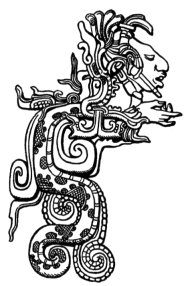뱀 은 가장 오래되고 널리 퍼진 신화 의 상징 중 하나이다. 뱀은 인류에 알려진 가장 오래된 의식의 일부와 연관되며[1] 선악 의 이중 표현 [2] [3]
마야 환상 뱀
Burston, Daniel: 1994, "Freud, the Serpent & The Sexual Enlightenment of Children", International Forum of Psychoanalysis, vol. 3, pp. 205–219
Joseph Campbell , Occidental Mythology: the Masks of God , 1964: Ch. 1, "The Serpent's Bride."John Bathurst Deane, The Worship of the Serpent : J. G. & F. Rivington, 1833. (alternative copy online at the Internet Archive )
David P. Chandler , A History of Cambodia , 1992.Lewis Richard Farnell, The Cults of the Greek States , 1896.
Joseph Eddy Fontenrose , Python; a study of Delphic myth and its origins , 1959.Jane Ellen Harrison , Themis: A Study of the Social Origins of Greek Religion , 1912. cf. Chapter IX, p. 329 especially, on the slaying of the Python.[4] [5] Haycock DE (2011). 《 Being and Perceiving》 ISBN 978-0-9569621-0-2 Isbell L (2009). 《 The Fruit, the Tree, and the Serpent》 ISBN 978-0674033016 Balaji Mundkur, The Cult of the Serpent: An Interdisciplinary Survey of Its Manifestations and Origins , Albany: State University Press 1983.
Edgar Allan Poe , The Cask of Amontillado , available in an online version at literature.org.Carl A. P. Ruck , Blaise Daniel Staples & Clark Heinrich, The Apples of Apollo: Pagan and Christian Mysteries of the Eucharist , 2001.
“ EOS” 원본 문서 에서 보존된 문서. 2012년 12월 7일에 확인함 . 